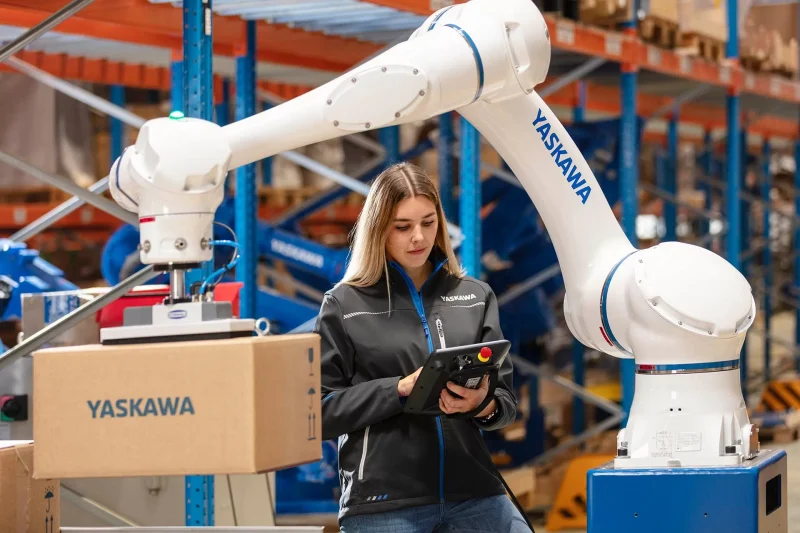Introduction
The Do’s of Robotics Implementation
- Identify tasks suitable for automation.
Begin with an analysis of tasks that are repetitive, predictable, and relatively safe to automate. In batch production, cobots are excellent for operations such as dosing raw materials or moving semi-finished products. For logistical tasks like pallet stacking or transporting heavy loads, industrial robots are often the best choice. Start with small, well-defined tasks to gain experience, and then scale up. - Select the right technology for the right purpose.
Cobots are designed to collaborate with humans and are ideal for flexible production environments. They can assist with tasks like mixing ingredients or replenishing production lines without posing risks to employees. Industrial robots, on the other hand, are more efficient for processes that require less human interaction and prioritize speed and strength. For automated internal logistics, Automated Guided Vehicles (AGVs) can be highly effective. - Integrate robotics with MES and WMS.
To maximize the potential of robots and cobots, integration with Manufacturing Execution Systems (MES) and Warehouse Management Systems (WMS) is essential. These systems enable robots to respond in real time to changes in production and inventory. For example, if a robot knows which materials are required for a specific recipe, it can automatically retrieve and prepare them. This increases efficiency and enhances visibility over internal logistics. - Consider scalability and flexibility.
Production requirements can fluctuate due to seasonal demand or new product launches. By investing in scalable robots and configurable systems, you can adapt to these changes without significant modifications. Cobots can be easily reprogrammed and are suitable for various production steps, allowing for quick adjustments as processes evolve. - Prioritize safety at every stage.
Cobots are safer than traditional robots and can often operate without safety cages. However, it is crucial to conduct a safety analysis in advance, especially when using industrial robots that operate at high speeds. Ensure proper shielding, sensors, and software-based safety measures are in place to prevent accidents, and keep employees well-informed about safety protocols.
The Don’ts of Robotics Implementation
- Do not neglect the need for regular training and maintenance.
Robots and cobots require regular maintenance and calibration to maintain optimal performance. Additionally, training employees is crucial so they not only know how to work safely with robots but are also capable of solving minor issues and recognizing the need for preventive maintenance. This reduces downtime and ensures higher production reliability. - Do not rush automation implementation.
A common mistake when deploying robots is attempting to automate too much too quickly. While Total Factory Automation may sound appealing, rapid implementation can disrupt existing workflows. Start with a pilot phase and test the robot in a defined production environment. Learn from the results before expanding to other parts of the factory or warehouse. - Do not undermine employee engagement.
Automation can sometimes create fear of job loss among employees. Ensure the team understands how robotics can support their work and the benefits it offers, such as reduced physical strain and more time for complex tasks. This fosters a positive workplace culture and minimizes resistance to change. - Do not overestimate initial costs.
Robotics implementation is a long-term investment. Besides purchase costs, you must account for installation, maintenance, and employee training. By conducting a ROI calculation upfront and setting aside budgets for unforeseen expenses, you can avoid financial surprises. - Do not ignore compliance and regulations.
Robots are becoming increasingly advanced, but every system must comply with relevant safety and regulatory requirements. Ensure that all robots and cobots in the factory or warehouse meet applicable safety standards and regulations to prevent accidents, fines, and other legal issues.
Conclusion: Make Robotics a Success in Your Production Environment
The implementation of robotics in the semi-process industry can deliver impressive benefits, especially in areas like internal logistics and batch production. By carefully planning, selecting the right technology, and prioritizing employee safety and engagement, cobots and robots can boost productivity while allowing you to adapt flexibly to demand.
Want to learn how your company can benefit from robotics and Total Factory Automation? Contact us for personalized advice!
Together, we prepare your production environment for the future with smart automation solutions. Share this article to inspire others and showcase the benefits of robotics in the semi-process industry!
Author is Harry Luijk – Manufacturing, Logistics & Supply Chain Professional – CCO at DH Automation Technology BV – Partner at Merlyn Consult.








